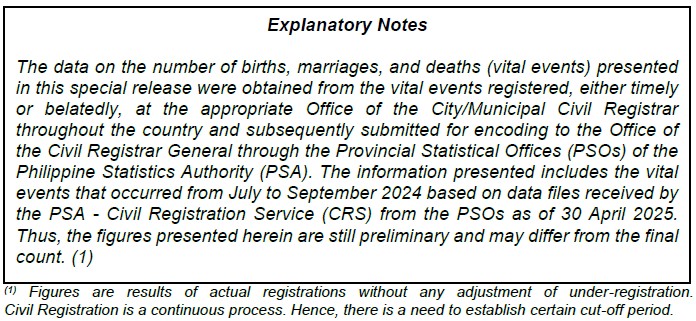
Number of registered births in Oriental Mindoro decreases in the Fourth Quarter
In the fourth quarter of 2024, there were 3,034 registered live births in the province of Oriental Mindoro. This figure showed decrease of 15.3 percent compared to the fourth quarter of 2023 with 3,580 live births. On the fourth quarter of 2024, the month of October had the highest registered births with 1,133 births or 37.3 percent of the total registered births in the fourth quarter. Followed by the month of November with 1,118 registered live births or 36.8 percent of the total registered births in the fourth quarter. (Figure 1)
Same trend was observed, when the fourth quarter of 2024 was compared to the third of 2024. There was a decrease of 42 live births equivalent to 1.4 percent. Third quarter of 2024 registered 3,076 live births, wherein the month of September registered the highest births with 1,141 or 37.1 percent of the total births in the third quarter. Followed by the month of August with 983 live births or 32.0 percent of the total births in the third quarter. (Figure 2)

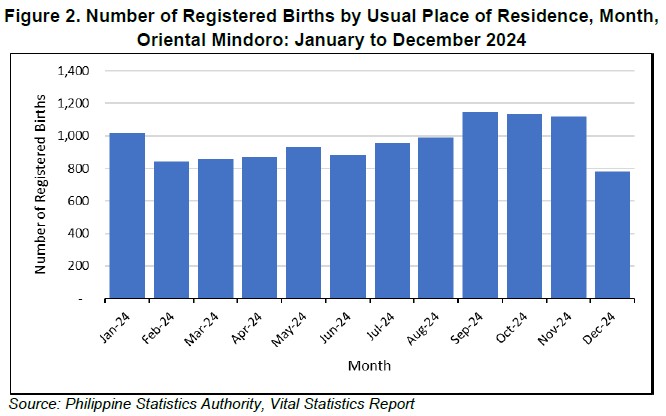
From January 2024 to December 2024, the month of September registered the highest number of births with 1,148 or 10.0 percent of total births. Followed by month of October with 1,133 registered births accounting for 9.8 percent of total births. Then by month of November with 1,118 registered births or 9.7 percent. The least number of registered births occurred in the month of December with 783 or 6.8 percent. (Figure 2)
More males were born than females
In 2024, more males (6,007 births or 52.1 percent share) were born than females (5,521 births or 47.9 percent share), resulting in a sex ratio at birth of 108.8 equivalent to 109 males per 100 females. (Figure 3)
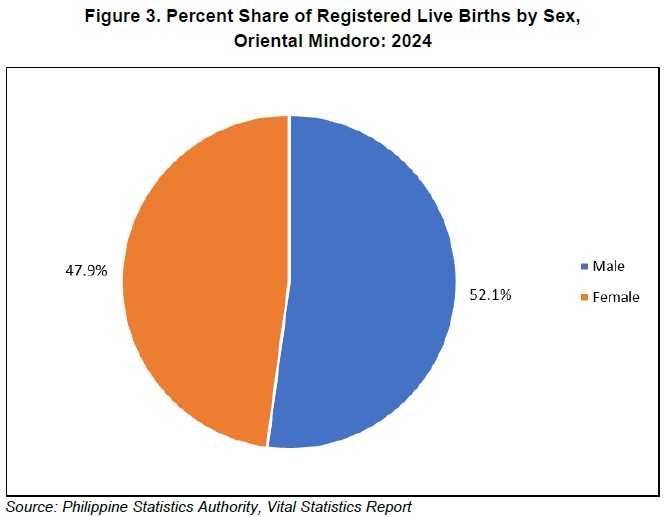
Registered marriages in the fourth quarter 2024 decreases
In the fourth quarter of 2024, there were 498 registered marriages in the province of Oriental Mindoro. This figure reflected a decrease of 33.6 percent compared to the fourth quarter of 2023 with 750 marriages. On the fourth quarter of 2024, the month of December had the highest registered marriages with 187 or 37.6 percent of the total registered marriages in the fourth quarter. Followed by the month of October with 178 registered marriages or 35.7 percent of the total registered marriages in the fourth quarter. (Figure 4)
Different trend was seen, when the fourth quarter of 2024 was compared to the third of 2024. There was an increase of 64 registered marriages equivalent to 14.8 percent. Third quarter of 2024 registered 434 marriages, wherein the month of July registered the highest marriages with 184 or 42.4 percent of the total marriages in the third quarter. Followed by the month of September with 171 marriages or 39.4 percent of the total marriages in the third quarter.
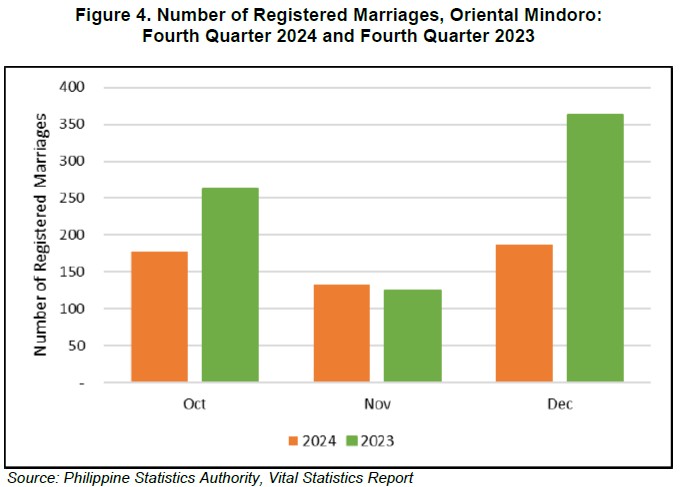
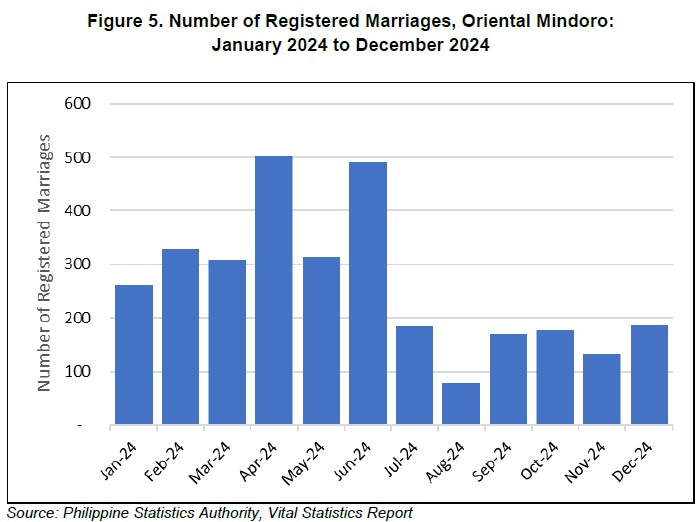
From January 2024 to December 2024, the month of April registered the highest number of marriages with 501 or 16.0 percent of total marriages. Followed by month of June with 492 registered marriages accounting for 15.7 percent of total marriages. Then by month of February with 329 registered marriages or 10.5 percent. The least number of registered marriages occurred in the month of August with 79 or 2.5 percent. (Figure 5)
(SGD) CHARLYN ROMERO-CANTOS, PhD
(Chief Administrative Officer)
Officer-in-Charge
Oriental Mindoro Provincial Statistical Office
TECHNICAL NOTES ON VITAL STATISTICS
INTRODUCTION
Vital statistics are derived from information obtained at the time when the occurrences of vital events and their characteristics are inscribed in a civil register.
Vital acts and events are the births, deaths, fetal deaths, marriages, and all such events that have something to do with an individual's entrance and departure from life together with the changes in civil status that may occur to a person during his lifetime. Recording of these events in the civil register is known as vital or civil registration and the resulting documents are called vital records.
STRUCTURE OF VITAL STATISTICS SYSTEM
The production of vital statistics comprised of a system of operations in which the registration of vital events is an important component. The system begins with the registration followed by the processing and controlling of vital records and ends with the compilation and analysis of vital statistics.
Under Commonwealth Act (CA) 591, the Bureau of Census (now Philippine Statistics Authority) is mandated to generate general purpose statistics and to carry out and administer Act No. 3753.
Under the same law, the head of the PSA is also the Civil Registrar General (CRG) who directs and supervises the local civil registration activities in the country. The CRG in this regard is empowered to prepare and issue implementing rules and regulations on civil registration and to prepare and order printed the necessary forms for proper compliance.
The set-up of vital statistics system involves different entities and cuts across different departments and personalities.
For the registration of vital events, the Local Civil Registry Offices (LCROs), which are the registration units in the country and headed by the City/Municipal Civil Registrars (C/MCRs), are under the Local Government Units (LGUs). The hospitals, clinics, rural health units and similar institutions including barangay secretaries, practicing physicians, midwives, nurses, traditional midwives, solemnizing officers from various religious sects and denomination are required to assist in the reporting of vital events for registration at the LCROs. The concerned parents, next of kin, contracting parties, a witness or the person who has full knowledge of the occurrence of the event are also required to report the event, in default of the first mentioned set of informants.
The processing and controlling of vital documents are done at the LCROs and at the PSA Provincial and Central Offices.
The compilation and analysis of vital statistics is taken cared of by the PSA Central Office under the Vital Statistics Division of the Civil Registration and Central Support Office.
THE REGISTRATION METHOD
As mandated in Act 3753, all vital events that marked the entry and departure of a person in his lifetime and the changes in his/her civil status shall be registered. The registration method is defined as the continuous, permanents and compulsory recording of the occurrences and characteristics of vital events, primarily for their value as legal documents and secondary for their usefulness as a source of statistics.
Place where to register the event
As a general rule, the place of registration is the LCRO of the city of municipality where the vital events occur.
Out of town reporting of vital event occurs when the documents presented to the civil registrar of LCRO, which is not the place of occurrence, not for registration but to be forwarded to the civil registrar of LCRO where the event occurred and where it should be registered.
Forms to use
The civil register consists of certificates and the registry book. It also includes the actual copies of the registrable court decisions and the legal instruments concerning the civil status of persons. The certificates are loose-leaf forms in a set of four copies except for the Certificate of Foundling which is in a set of three.
Person who will report the event
The informant is the one who reports the event for registration and who gives information to be recorded in the civil register.
For death occurrences, the report shall be made by the hospital or clinic administrator if the person dies in the hospital or clinic, or by attending physician or by the nearest relative or by any interested party who has knowledge of the occurrence of death. In all cases, the report shall be submitted to the Local Health Officer (LHO) who shall direct and order the C/MCR to enter the death in the civil register.
Period when to report the event
Death or fetal death shall be reported to LHO within forty eight (48) hours from the time of death and the LHO shall direct or cause the registration to the C/MCR not later than thirty (30) days from date of death.
Any report made to the LCROs beyond the reglementary period are considered late and can be entered only in the civil register after the informant complies with the requirements for delayed registration.
Operative Act of Registration
The C/MCR sees to it that appropriate form it used; form is properly and completely filled-up; and proper attachments are submitted. In case, the entries are found incomplete, the C/MCR has to require the person concerned to fill up the document completely or to correct the entries.
When the document is accepted for registration, the date of receipt is recorded in the space provided and the documents received for the day are entered immediately in the appropriate civil registry book, assigning therein the corresponding registry number. After registration entry/entries found erroneous can only be corrected through RA 9048, except sex, nationality, age and status which require court approval.
Distribution of registered documents
Upon registration, the C/MCR distributes the copies accordingly: the first copy to the informant; the second copy to the CRG; the third copy shall be retained by the LCRO; and the fourth copy to the attendant or solemnizing officer, as the case may be. The CRG copy is the source of vital statistics published in this report.
DEFINITION OF TERMS AND CONCEPTS
Significant terminologist and descriptions in the foregoing highlights and tables are defined below. Included are some items found in the certificates and summary measure used in describing the facts of events.
Death refers to the permanent disappearance of all evidence of life at any time after live birth has taken place (postnatal cessation of vital function without capability of resuscitation).
Crude Death Rate (CDR) refers to the number of deaths per 1,000 mid-year population.
Daily Average refers to the arithmetic mean of birth, death or marriage occurrences per day.
Daily Index is the increase/decrease from the overall daily average of event occurrences.
Usual Residence refers to the place where the person habitually or permanently resides.
Place of Occurrence refers to the place where the vital event took place.

